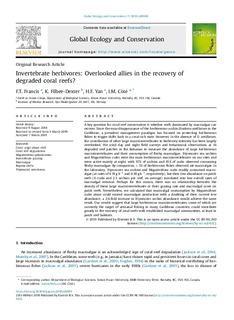| dc.description.abstract | A key question for coral reef conservation is whether reefs dominated by macroalgae can recover. Since the near-disappearance of the herbivorous urchin Diadema antillarum in the Caribbean, a prevalent management paradigm has focused on protecting herbivorous fishes to trigger shifts back to a coral-rich state. However, in the absence of D. antillarum, the contribution of other large macroinvertebrates to herbivory intensity has been largely overlooked. We used day and night field surveys and behavioural observations at 16 degraded reef patches in the Bahamas to measure the abundance of large herbivorous macroinvertebrates and their consumption of fleshy macroalgae. Tripneustes sea urchins and Maguimithrax crabs were the main herbivorous macroinvertebrates on our sites and were active mainly at night, with 97% of urchins and 45% of crabs observed consuming fleshy macroalgae. By comparison, < 5% of herbivorous fishes observed ate macroalgae. In the laboratory, Tripneustes sea urchins and Maguimithrax crabs readily consumed macroalgae (at rates of 0.19 g h−1 and 0.38 g h−1, respectively), but their low abundance on patch reefs (4 crabs and 2.3 urchins per reef, on average) translated into low overall rates of macroalgal removal. Perhaps for this reason, there was no relationship between the density of these large macroinvertebrates or their grazing rate and macroalgal cover on patch reefs. Nevertheless, we calculated that macroalgal consumption by Maguimithrax crabs alone could exceed macroalgae production with a doubling of their current low abundance; a 2.6-fold increase in Tripneustes urchin abundance would achieve the same result. Our results suggest that large herbivorous macroinvertebrates, some of which are currently the target of artisanal fishing in many Caribbean countries, could contribute greatly to the recovery of coral reefs with established macroalgal communities, at least in patch reef habitats. | nb_NO |
